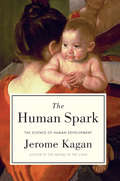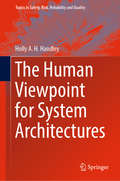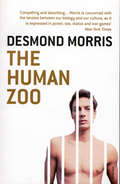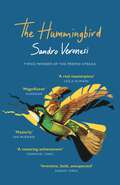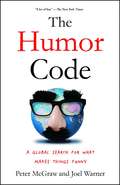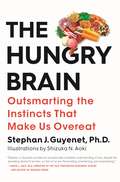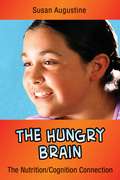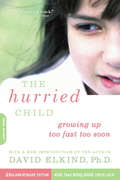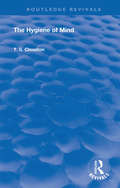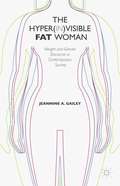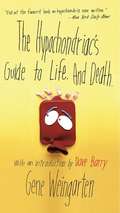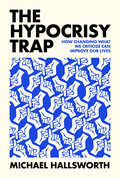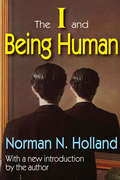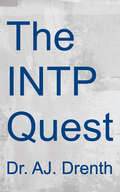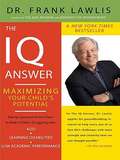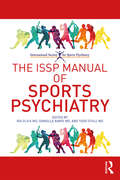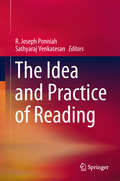- Table View
- List View
The Human Spark: The Science of Human Development
by Jerome KaganWhat makes a human a human? In The Human Spark, pioneering psychologist Jerome Kagan offers an answer in a sweeping narrative of our personal, moral, and cultural development. In this extended meditation on human psychology as well as the methods, successes, and failures of the scientists who study it. Kagan calls out the shortcomings of the modern fad for neuroscience, and questions psychiatry’s quickness to pathologize the behavior of the young. More importantly, he reminds us that our lives, however influenced by biology and upbringing, are still a tapestry to be woven, not an outcome to be endured. Whether the reader is a first-time parent wondering what influence she, her genes, and the wider world will have on her child; an educator seeking insight into the development of her students; or simply a curious soul seeking self-knowledge, Kagan makes an expert and companionable guide.
The Human Swarm: How Our Societies Arise, Thrive, and Fall
by Mark W. MoffettThe epic story and ultimate big history of how human society evolved from intimate chimp communities into the sprawling civilizations of a world-dominating species <P><P>If a chimpanzee ventures into the territory of a different group, it will almost certainly be killed. But a New Yorker can fly to Los Angeles--or Borneo--with very little fear. <P><P>Psychologists have done little to explain this: for years, they have held that our biology puts a hard upper limit--about 150 people--on the size of our social groups. But human societies are in fact vastly larger. How do we manage--by and large--to get along with each other? <P><P>In this paradigm-shattering book, biologist Mark W. Moffett draws on findings in psychology, sociology and anthropology to explain the social adaptations that bind societies. He explores how the tension between identity and anonymity defines how societies develop, function, and fail. <P><P>Surpassing Guns, Germs, and Steel and Sapiens, The Human Swarm reveals how mankind created sprawling civilizations of unrivaled complexity--and what it will take to sustain them.
The Human Viewpoint for System Architectures (Topics in Safety, Risk, Reliability and Quality #35)
by Holly A.H. HandleyThis book describes a methodology to represent socio-technical system concerns in the system architecting process. The resulting set of Human Views augments traditional system viewpoints with human-focused data. The Human Viewpoint methodology classifies the socio-technical system context, identifies and collects pertinent data, renders models that can be used for discussion and analysis, and presents the results in Fit for Purpose views that are useful for decision making. The inclusion of the Human Viewpoint during the system architecting stage allows the evaluation of human-system design trade-offs, recognises the impact of the human operator on system performance, and provides the foundation for Human System Integration evaluations during the ensuing system development.
The Human Zoo
by Desmond MorrisA must-read for anyone who has ever wondered why people do what they do, from the popular author of The Naked Ape.This study concerns the city dweller. Morris finds remarkable similarities with captive zoo animals and looks closely at the aggressive, sexual and parental behaviour of the human species under the stresses and pressures of urban living.‘Compelling and absorbing...Morris is concerned with the tension between our biology and our culture, as it is expressed in power, sex, status and war games’ New York Times
The Human and Social Dimension of Urban Lightscapes (SpringerBriefs in Applied Sciences and Technology)
by Daria CascianiThis book explores new criteria and characteristics for integrating human psychology in the design of modern urban lighting. It identifies a new area of lighting design research and practice that focuses on the nocturnal urban experience in terms of people’s emotional, cognitive and motivational perceptions to achieve more accessible, sociable and sustainable cities. In turn, the book compares new tools and research methodologies for tackling complex issues concerning the ties between lighting, people and the city. Moreover, it presents a series of case studies to provide an in-depth understanding of the influence of urban lighting in terms of luminous atmosphere perception, positive social affect, social enhancement, accessibility and hospitability. Lastly, the book proposes a multidisciplinary qualitative and quantitative methodology for assessing the spatial experience of outdoor lighting.
The Human as Animal Symbolicum: Origins of Symbolic Function (Social Interaction in Learning and Development)
by Ivan D. IvićThis book renews the concept of the symbolic function, exploring human capacity to create and utilize symbols, semiotic systems, and realities. It offers a unique theoretical perspective on the early psychological growth of children, focusing on the symbolic function's role in their development . In this sense, it offer new conception of the emergence of symbolic function and language. It further presents detailed analyses of semiotic function manifestations and their integration around age three, signifying a child's entry into the "symbolic species" and its profound influence on overall mental development. This book deals with issues related to the symbolic function in general, as well as its origin and development. It further presents detailed analyses of semiotic function manifestations and their integration around age three, signifying a child's entry into the symbolic species and its profound influence on overall mental development. This text serves as a valuable academic resource for university teachers, researchers and students interested in gaining a comprehensive understanding of the complex interplay between cognitive, socio-emotional development, and social practices in the emergence of symbolic function in early childhood.
The Human-Animal Bond in Clinical Social Work Practice (Essential Clinical Social Work Series)
by Katherine CompitusThe human-animal bond may be described as a dynamic, mutually beneficial relationship between people and the animals they care for. There are a multitude of mental and physical health benefits for people who care for animals, and animals in therapy have been shown to aid a wide range of people and illnesses. Although the benefits of animal companionship have long been suspected, little is known about the research, the process, or why it works. This book provides clinicians with a history of the human-animal bond and the rationale for incorporating animals into therapy today.In this book, the author includes a discussion of the myriad of ways that clinicians can directly help people care for their pets, such as crisis intervention services, policy issues, grief counseling for pet loss, and compassion fatigue in the veterinary profession. There also is a thorough discussion of animal-assisted therapy (AAT) as a distinct and unique modality. The adaptive nature of AAT is not only due to the symbiotic relationship between humans and animals, but also because of the flexible nature of the model; it can be used with clients of all demographics and with most mental illnesses. Research shows that the majority of mental health practitioners believe that AAT is a valid treatment modality, but AAT has not yet been manualized and clinicians are left confused about where to start. The Human-Animal Bond in Clinical Social Work Practice is a unique and essential resource that provides guidelines for developing AAT treatment plans and integrating AAT with existing therapeutic models. The book answers the questions that social workers, psychologists, psychiatrists, and other mental health counselors may have about the benefits of the human-animal bond and ways to tap into that special bond in direct practice.
The Hummingbird: ‘Magnificent’ (Guardian)
by Sandro VeronesiA BOOK OF THE YEAR FOR THE GUARDIAN: 'DEEPLY PLEASURABLE'A BOOK OF THE YEAR FOR THE SPECTATOR: 'WHAT A JOY''Magnificent' Guardian'A towering achivement' Financial Times'Inventive, bold, unexpected' Sunday Times'Everything that makes the novel worthwhile and engaging is here: warmth, wit, intelligence, love, death, high seriousness, low comedy, philosophy, subtle personal relationships and the complex interior life of human beings'Guardian'Not since William Boyd's Any Human Heart has a novel captured the feast and famine nature of a single life with such invention and tenderness'Financial Times'There is a pleasing sense of having grappled with the real stuff of life: loss, grief, love, desire, pain, uncertainty, confusion, joy, despair - all while having fun'The Sunday Times'Instantly immersive, playfully inventive, effortlessly wise'Observer'Masterly: a cabinet of curiosities and delights, packed with small wonders'Ian McEwan'A real masterpiece. A funny, touching, profound book that made me cry like a little girl on the last page'Leïla Slimani'A remarkable accomplishment, a true gift to the world'Michael Cunningham'Ardent, gripping, and inventive to the core'Jhumpa LahiriMarco Carrera is 'the hummingbird,' a man with the almost supernatural ability to stay still as the world around him continues to change.As he navigates the challenges of life - confronting the death of his sister and the absence of his brother; taking care of his parents as they approach the end of their lives; raising his granddaughter when her mother, Marco's own child, can no longer be there for her; coming to terms with his love for the enigmatic Luisa - Marco Carrera comes to represent the quiet heroism that pervades so much of our everyday existence.A thrilling novel about the need to look to the future with hope and live with intensity to the very end.THE NO. 1 INTERNATIONAL BESTSELLEROver 300,000 copies soldSoon to be a major motion pictureWinner of the Premio StregaWinner of the Prix du Livre EtrangerBook of the Year for the Corriere della Sera
The Humor Code: A Global Search for What Makes Things Funny
by Joel Warner Peter McGrawPart road-trip comedy and part social science experiment, a scientist and a journalist “shed fascinating light on what makes us laugh and why” (New York Post).Two guys. Nineteen experiments. Five continents. 91,000 miles. The Humor Code follows the madcap adventures and oddball experiments of Professor Peter McGraw and writer Joel Warner as they discover the secret behind what makes things funny. In their search, they interview countless comics, from Doug Stanhope to Louis CK and travel across the globe from Norway to New York, from Palestine to the Amazon. It’s an epic quest, both brainy and harebrained, that culminates at the world’s largest comedy festival where the pair put their hard-earned knowledge to the test. For the first time, they have established a comprehensive theory that answers the question “what makes things funny?” Based on original research from the Humor Research Lab (HuRL) at the University of Colorado, Boulder, and the pair’s experiences across the globe, The Humor Code explains the secret behind winning the New Yorker cartoon caption contest, why some dead baby jokes are funnier than others, and whether laughter really is the best medicine. Hilarious, surprising, and sometimes even touching, The Humor Code “lays out a convincing theory about how humor works, and why it’s an essential survival mechanism” (Mother Jones).
The Hungry Brain: Outsmarting the Instincts That Make Us Overeat
by Stephan J. GuyenetFrom an obesity and neuroscience researcher with a knack for engaging, humorous storytelling, The Hungry Brain uses cutting-edge science to answer the questions: why do we overeat, and what can we do about it? No one wants to overeat. And certainly no one wants to overeat for years, become overweight, and end up with a high risk of diabetes or heart disease--yet two thirds of Americans do precisely that. Even though we know better, we often eat too much. Why does our behavior betray our own intentions to be lean and healthy? The problem, argues obesity and neuroscience researcher Stephan J. Guyenet, is not necessarily a lack of willpower or an incorrect understanding of what to eat. Rather, our appetites and food choices are led astray by ancient, instinctive brain circuits that play by the rules of a survival game that no longer exists. And these circuits don’t care about how you look in a bathing suit next summer.To make the case, The Hungry Brain takes readers on an eye-opening journey through cutting-edge neuroscience that has never before been available to a general audience. The Hungry Brain delivers profound insights into why the brain undermines our weight goals and transforms these insights into practical guidelines for eating well and staying slim. Along the way, it explores how the human brain works, revealing how this mysterious organ makes us who we are.
The Hungry Brain: The Nutrition/Cognition Connection (The\nutshell Ser.)
by Susan AugustineFeed the brain first to make the nutrition/cognition connection! Focusing on nutrition's role in promoting learning, the author calls on educators to model good food choices for their students. Building on a simple three-part framework of plant foods, animal foods, and junk foods, and incorporating exercise, the text shows educators how: Healthy eating provides a powerful link to learning Childhood obesity, food allergies, and other disorders may be related to eating habits Breakfast is still the most important meal of the day Brain-jogging exercises enhance brain activity, improve physical health, increase clarity, and reduce stress
The Hungry Mind
by Susan EngelDespite American education's mania for standardized tests, testing misses what matters most about learning: the desire to learn in the first place. Susan Engel offers a highly readable exploration of what curiosity is, how it can be measured, how it develops in childhood, and how educators can put curiosity at the center of the classroom.
The Hurried Child-25th Anniversary Edition
by David ElkindWith the first edition of The Hurried Child, David Elkind emerged as the voice of parenting reason, calling our attention to the crippling effects of hurrying our children through life. He showed that by blurring the boundaries of what is age appropriate, by expecting--or imposing--too much too soon, we force our kids to grow up too fast, to mimic adult sophistication while secretly yearning for innocence. In the more than two decades since this book first appeared, new generations of parents have inadvertently stepped up the assault on childhood, in the media, in schools, and at home. In the third edition of this classic (2001), Dr. Elkind provided a detailed, up-to-the-minute look at the Internet, classroom culture, school violence, movies, television, and a growing societal incivility to show parents and teachers where hurrying occurs and why. And as before, he offered parents and teachers insight, advice, and hope for encouraging healthy development while protecting the joy and freedom of childhood. In this twenty-fifth anniversary edition of the book, Dr. Elkind delivers important new commentary to put a quarter century of trends and change into perspective for parents today.
The Husband Swap
by Louisa LeontiadesLouisa and Gilles love each other. There’s a problem in paradise, though: their marriage is going nowhere. Together, they decide to explore polyamory, the idea that it’s possible to have more than one lover--and more than one love. They fall in love with another couple and, embarking on a life-changing course, try to make it work as a quad. Their journey liberates them from the constraints of their unhappy marriage and propels them into a world where they embrace a new way of loving. But this liberation comes with a price. They are challenged in ways they didn’t expect, and the experiment takes them to a place they didn’t anticipate. They must learn to accept a new understanding of relationships, each other and themselves. With raw and intimate prose, Louisa Leontiades unflinchingly shares her story, with all its drama, passion, joy and conflict as she and her husband stumble, make mistakes, and look for a path to a sustainable polyamorous future. This is not a how-to manual or a guide to polyamory. It is the true story of four ordinary people who challenged monogamy to pursue a utopia of limitless love.
The Hygiene of Mind (Routledge Revivals)
by T. S. CloustonOriginally published in 1906. How the mind of man can be strengthened, widened, and made a more efficient instrument through the application of modern scientific and physiological knowledge is a question of intense interest. It is now a universally accepted fact that the body is capable of improvement by the application of hygienic rules, and that thereby the life of man and his happiness are bettered. It is also proved by physiology that mental action is absolutely co-related with brain action, and it therefore does not admit of doubt that the mind may also be bettered through brain and bodily hygiene. This book includes chapters on the mind machinery in the brian; how the brain mechanism works in regard to mind; and te mental hygiene of bodily disease.
The Hyper(in)visible Fat Woman
by Jeannine A. GaileyIn The Hyper(in)visible Fat Woman Gailey investigates the interface between fat women's perceptions of their bodies and of the social expectations and judgments placed on them. The book explores the phenomenon of 'hyper(in)visibility', the seemingly paradoxical social position of being paid exceptional attention while simultaneously being erased.
The Hypochondriac's Guide to Life. And Death.
by Gene WeingartenWhen every hiccup sounds like the call of doom, each stomach pang hints at incipient cancer, and a headache means it's time to firm up your last will and testament, The Hypochondriac's Guide to Life. And Death. provides just the relief you need. Gene Weingarten has spent his whole life immersed in the eclectic details of bizarre symptoms, self-diagnosing every minor ache as a potentially deadly disease. Weingarten examines:The mind of a hypochondriacHow your doctor can kill youUlcers and other visceral fearsThe snaps, crackles, and pops of your body that spell disasterThings that can take an eye outInterpreting DocSpeakBlending the neurotic anxieties of Woody Allen, the folksiness of Garrison Keillor, and the absurdist vision of Dave Barry, Gene Weingarten conjures up a hilarious prescription for the hypochondriac that lurks inside all of us.
The Hypocrisy Trap: How Changing What We Criticize Can Improve Our Lives
by Michael HallsworthHow our desire to stamp out hypocrisy is backfiring—and how learning to target our criticisms better can improve our politics, business, and personal relationships.In our increasingly distrusting and polarized nations, accusations of hypocrisy are everywhere. But the strange truth is that our attempts to stamp out hypocrisy often backfire, creating what Michael Hallsworth calls The Hypocrisy Trap. In this groundbreaking book, he shows how our relentless drive to expose inconsistency between words and deeds can actually breed more hypocrisy or, worse, cynicism that corrodes democracy itself.Through engaging stories and original research, Hallsworth shows that not all hypocrisy is equal. While some forms genuinely destroy trust and create harm, others reflect the inevitable compromises of human nature and complex societies. The Hypocrisy Trap offers practical solutions: ways to increase our own consistency, navigate accusations wisely, and change how we judge others&’ actions. Hallsworth shows vividly that we can improve our politics, businesses, and personal relationships if we rethink hypocrisy—soon.
The I Ching: Points of Balance and Cycles of Change
by Peggy JonesCentred on the study of sixty-four 6-line figures (The Hexagrams) representing the yin and yang of the ten thousand things under Heaven, The Classic of Changes or I Ching is one of the oldest books in the world. In this revisioning of the I Ching, the author explores the processes of change and balance as reflected in the hexagrams for the contemporary reader.
The I and Being Human
by Norman HollandThe'I' in the title pertains to the core of self that persists over time. These are challenges that elude people like social scientists, philosophers, or critics of literature and the arts, who would chronicle or explain humanity's doings. This informative, engaging, and joyous book by Norman N. Holland offers a usable model for the aesthetics, psychology, history, and science of the human subject.Holland begins by modeling the self as a theme and variations, constant yet constantly changing. He shows how symbolization, perception, cognition, and memory all contribute to the sense of I, hence how any one I grows out of a specific history and culture but also out of experiences all humans share.Holland proposes a scientific psychology based on his model, fusing the experiments of academic psychology with the insights of psychoanalysis. He illustrates his theory by the lives of George Bernard Shaw, Scott Fitzgerald, and other writers, as well as Freud's patient "Little Hans," in adulthood a famed stage director at the Metropolitan Opera. The I and Being Human attempts nothing less than to draw together aspects of the self, such as objectivity and subjectivity, that have eluded connection. In so doing, Norman Holland offers a rereading of psychoanalysis as a theory of the I.
The I and the Not-I: A Study in the Development of Consciousness (Bollingen Series (General) #633)
by Mary Esther HardingThis book provides a very accessible general introduction to the Jungian concept of ego development and Jung's theory of personality structure--the collective unconscious, anima, animus, shadow, archetypes.
The INTP Quest: INTPs' Search for Their Core Self, Purpose, and Philosophy
by A. J. DrenthINTPs are equal parts thinker and seeker. While their status as nuanced and critical thinkers rarely goes unrecognized, their seeking side is often overlooked. This is largely due to the fact they do most of their seeking inwardly, that is, by way of thinking. Recognizing life’s brevity, INTPs strive to craft a life that is important, meaningful, and authentically reflects who they are. In so doing, they feel compelled to clarify their understanding of three key things: their core self, their purpose, and their philosophy / worldview. Only by clarifying these foundational matters can INTPs be sure they have done everything possible to optimize their lives. Unfortunately, the INTP quest is rarely simple or straightforward, and it often extends far longer than they anticipate. Plagued by doubt and uncertainty, some INTPs may worry that they may never find what they are looking for and that all their explorations will have been for naught. However, those who persist in their quest have good reason for hope. While their destination may not look quite as shiny or glorious as they originally imagined, it is nonetheless worth the wait, capable of furnishing them with an enduring sense of meaning and satisfaction. This book explores the deep existential concerns that INTPs strive to understand and resolve through their quest.
The IQ Answer
by Dr Frank LawlisIn the bestselling The ADD Answer, Dr. Frank Lawlis provided thousands with valuable information about treatments for ADD and ADHD. Now he shares his expert advice on how to unleash the power of the mind. Through his groundbreaking thirteen-step method, Dr.Lawlis offers clear, easy-to-follow strategies for overcoming thinking patterns that hamper success. Many case studies of his former patients illustrate how these simple techniques can change lives. The result of years of clinical research, his program is a mind, body, and soul approach that includes breathing exercises and nutritional advice. The IQ Answer is a fascinating and user-friendly guide to fulfilling one's potential. With millions of new cases of ADD and other learning disabilities diagnosed every year, parents are searching for solutions to help them break through their children's performance plateaus. And any adult who has ever been frustrated by a stubborn mental block will learn the steps to scale it and tackle any project creatively. Written in response to the overwhelming need that Dr. Lawlis sees every day in his practice and in his role as Dr. Phil's primary contributing psychologist, The IQ Answer will be a powerful tool for all those who want to be as successful as they can be.
The ISSP Manual of Sports Psychiatry
by Ira D. Glick Stull Todd Danielle KamisThe ISSP Manual of Sports Psychiatry is the first text describing the role of a sports psychiatrist. Covering both individual as well as team sports, contact and non-contact, from childhood through late adulthood, the manual describes the role of sports in our culture and details the psychiatric interventions associated with players and their teams. The editors take a broad focus, covering topics from neuroscience-psychiatric and psychological aspects, performance enhancement, team chemistry and dynamics, organizational issues to working with medical, orthopedic/surgical and neurologic colleagues to provide comprehensive prevention and treatment to enhance well-being and performance. This text will be invaluable to medical and psychiatric physicians, psychologists and other mental health professionals, as well as athletes, trainers, leagues and their commissioners, sports writers-and even "fans" anxious to understand what is going on with their teams.
The Idea and Practice of Reading
by R. Joseph Ponniah Sathyaraj VenkatesanThis book addresses basic issues in language education and explores how reading, with a focus on meaning, contributes to the development of all aspects of language including vocabulary, spelling, grammar, and syntax. It departs from traditional methods and practices in language learning to investigate the potency of reading in improving language acquisition. The traditional practice in language classes to teach language skills explicitly through acquiring forms and structures of language is often less than successful, and teachers are gradually incorporating reading materials and practices into the curriculum. This book provides important inputs to language teachers and educators on the need to include reading as an idea and as a practice into the curriculum. Among other things, it explores the benefits of incidental learning of language properties such as vocabulary, syntax and grammar and gives adequate exposure to different types of reading strategies to promote reading among learners. It also exploits the possible transfer of L1 reading strategies and capabilities to L2 reading for language acquisition. In so doing, this book hopes to promote autonomous learning among L2 learners and guide readers in alternative strategies to solve comprehension problems.
